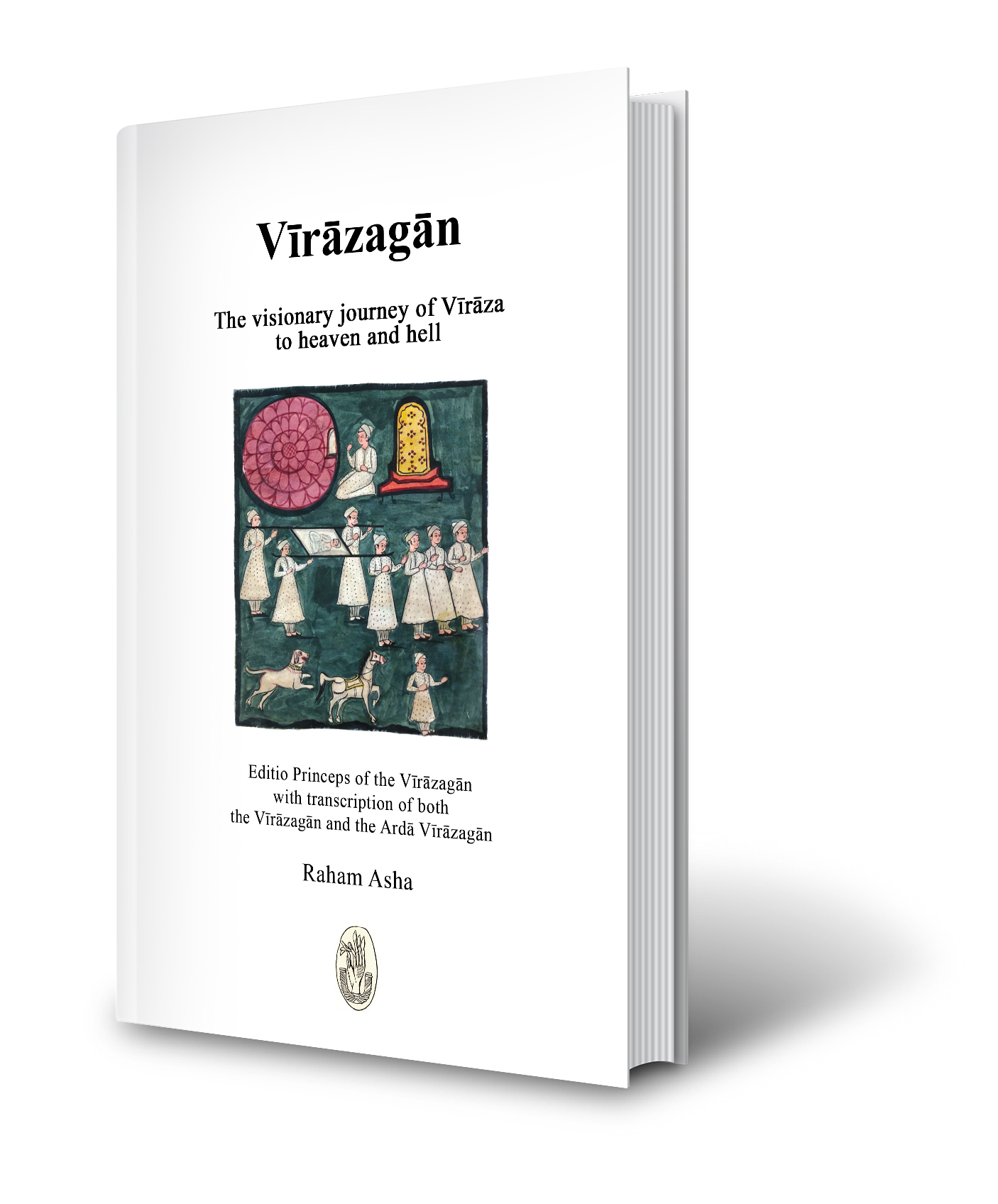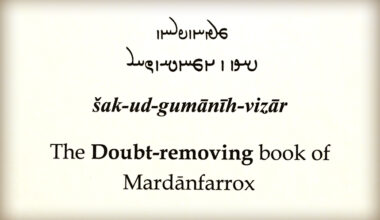Raham Asha, Vīrāzagān: The visionary journey of Vīrāza to heaven and hell, Editio Princeps of the Vīrāzagān with transcription of both the Vīrāzagān and the Ardā Vīrāzagān, Third published (second edition), Mumbai, K. R. Cama Oriental Institute, 2024, ISBN 978-2-9579653-3-5.
First edition: Raham Asha, Vīrāzagān: The visionary journey of Vīrāza to heaven and hell, Editio Princeps of the Vīrāzagān with transcription of both the Vīrāzagān and the Ardā Vīrāzagān, First published, Tehran, Shourafarin, 2017, ISBN 978-600-8055-97-6; Second published, Tehran, Sade, 2017, ISBN 978-600-98270-2-2.
Acknowledgments
After a long time, I had an opportunity again, recently, to visit the K. R. Cama Oriental Institute, and to see and read some of the old Avesta and Pārsīg manuscripts, especially the newly found manuscript TD 26. I thank again the librarians and the members of the staff for their willing, kind and courteous services at the library.
I thank also Ardashir Goldust for carefully reading the work and suggesting some corrections. I am indebted to Bozorgmehr Loghman and Mazda Tajbakhsh for kindly deciding to publish this work.
Raham Asha
vahman rōz ī vahman māh ī 1386 yazdgirdīg
(May 15, 2017) ped Arrou
Introduction
An account, the Vīrāzagān, belonging to the Perso-Aryan visionary tradition, is about the celestial journey of a Magian priest and his descent into the subterranean world of demon spirits. [1] The name of the hero is known from the Avesta, vīrāza (Pers. vīrāz, vīrāf)[2], where his fravaṣ̌i-soul is mentioned in the list of the aṣ̌avan[3]: vīrāzahe aṣ̌aonō fravaṣ̌īm yazamaide ‘We worship the fravaṣi of the truthful Vīrāza’.[4] The only copy of the Vīrāzagān is found in the Codex TD 26 (Ms. R 494), 49r-62v.[5] It was copied from the manuscript of the Persian scribe, Hōšang of Syāvxaš, based on the manuscript of Gōbedšāh of Rustam. According to this text, Vīrāza who flourished in the time of king Vištāspa after the demise of Zaraθuštra, was sent by the king from “the world of living beings” (šahr ī zīndagān) to the “world of the dead” (šahr ī murdagān). He drank a soporific mixture prepared by his seven sisters, and fell in an altered state; two divine beings, Sraoša and Ātar, led him to the Bridge of the Accountant (cinvatō pǝrǝtu, Pers. cinvad puhl) where the divine judge Rašnu was weighing the thoughts, words and deeds of the dead on his scale, and they brought him forth to Ahura Mazdā, and also led him to the place where the damned were tormented by the Daēva and the Druj.
The above text is different from the well-known Ardā-Vīrāz-nāmag (AVN).[6] The AVN is a rewriting of the original text by the Persian Magi to conform it to the spirit of the Sasanian period –for example, they did not clearly mention the next-of-kin marriage (between a brother and a sister) –, and to make Vīrāza a mogu who flourished after the time of Ardašēr and Ādurbād. There are a number of Pāzand, Persian and Gujarati versions which are based on the AVN.[7]
The AVN does not come directly from the Vīrāzagān, but from another old version which was used for the redaction of a Pāzand version of the account of the vision, with the title ardā vīrāzagān[8]. This Pāzand version in various particulars besides the introduction differs from the AVN. For example, it places the journey of Vīrāza after the demise of Zaraθuštra in Vīštāspa’s reign. The pāzand text was translated into Sanskrit (अर्दाग्वीरानामपुस्तकं), and the Sanskrit text in turn was rendered into old Gujarāti.[9]
Nōšervān Marzbān who had access to the Vīrāzagān, and read it with the help of two other priests, decided to complete the metrical version of Zartušt Bahrām, and prepared a Persian version of the account of the vision in verse.[10]
Notice that even if the Vīrāzagān differs from the Ardā-Vīrāz Nāmag (AVN), it helps us to give a more correct transcription and understanding of the latter.
To read the full preface and notes, see: vīrāzagān: The visionary journey of Vīrāza to heaven and hell, pp 9-13.
Purchase
To purchase the PDF version of the book, please send an email to the address below. In your email, kindly indicate whether you are purchasing from within Iran or from outside Iran, so that the appropriate purchasing method can be provided.
PersoAryanStudies@gmail.com
ویرازگان: یک نوشتهی نویافته به پارسیگ







1 comment